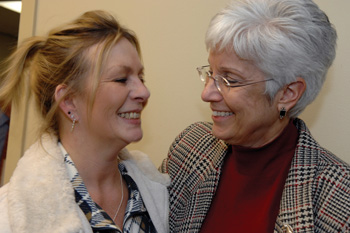
Peter Buerhaus, Ph.D., R.N., and Colleen Conway-Welch, Ph.D., R.N., were among VMC’s representatives at this week’s discussion. (photo by Anne Rayner)
Panel examines avenues to ‘high-value’ health care
The keys to healing our nation's splintered, wasteful and often ineffective health care system are not hidden. They lie right before us, if we would only pick them up.
That was one point of agreement that emerged Monday from a panel discussion on “high-value” health care at the Loews Vanderbilt Hotel sponsored by the Washington, D.C.-based Bipartisan Policy Center.
“Why can we track a package to China and back, and we lose a patient on the way to X-ray?” asked Colleen Conway-Welch, Ph.D., R.N., dean of the Vanderbilt University School of Nursing.
“I can take my car to any Jiffy Lube in the country and they can read my car's history,” added Jonathan Perlin, M.D, Ph.D., chief medical officer of Hospital Corporation of America. “I challenge anyone to do that in health care.”
Information, argued Conway-Welch and Perlin, is one of the keys to reform.
Harry Jacobson, M.D., Vanderbilt's vice chancellor for Health Affairs, noted that the application of “knowledge-based medicine” markedly reduced rates of ventilator-associated pneumonia and bloodstream infections at Vanderbilt University Hospital.
When physicians learned how much they spent treating patients at the hospital compared to their colleagues, the cost of their discharges dropped by 14 percent, he added.
Using technology developed by Vanderbilt Medical Center, hospital emergency rooms in Memphis now can exchange information about patients' previous imaging studies, thereby avoiding unnecessary repeat studies and saving millions of dollars a year.
Investing in electronic medical records and evidence-based decision support “doesn't have to be expensive,” Jacobson said. “The return is quick, and it's a great return.”
Other looming problems will require a longer-term investment.
If current trends continue, the nation will be short 500,000 nurses by the year 2025, said Peter Buerhaus, Ph.D., R.N., director of the Center for Interdisciplinary Health Workforce Studies in the Vanderbilt Institute for Medicine and Public Health.
The nursing workforce is graying rapidly, yet “we're turning away 30,000 to 40,000 people from becoming nurses every year,” he said.
Why? Not enough nursing school faculty, not enough places for students to learn their clinical skills, and an “underinvestment in technology — the hardware of teaching,” Conway-Welch explained.
Of the 700 students enrolled in Vanderbilt's Nursing School, only 350 are on campus. The rest receive their lessons electronically.
Another daunting challenge is providing health care coverage to the poor and underserved.
“We don't need more paperwork,” argued Nancy Anness, M.S.N., vice president for Advocacy, Access and Community Outreach at Saint Thomas Health Services, which provides care in some of the neediest and most remote parts of Middle Tennessee. “We need access and we need coverage … We're advocating for 100 percent access.”
Former U.S. Senate Majority Leader Howard Baker, of Tennessee, who co-founded the Bipartisan Policy Center in 2007 with three Senate colleagues to help solve the nation's most vexing problems, hosted the discussion. Baker warned that the emphasis on information technology could “mechanize” health care.
“Computers are not the whole show,” he continued, “but if you give me a choice between a computer and a good doctor, I'd choose both.”













